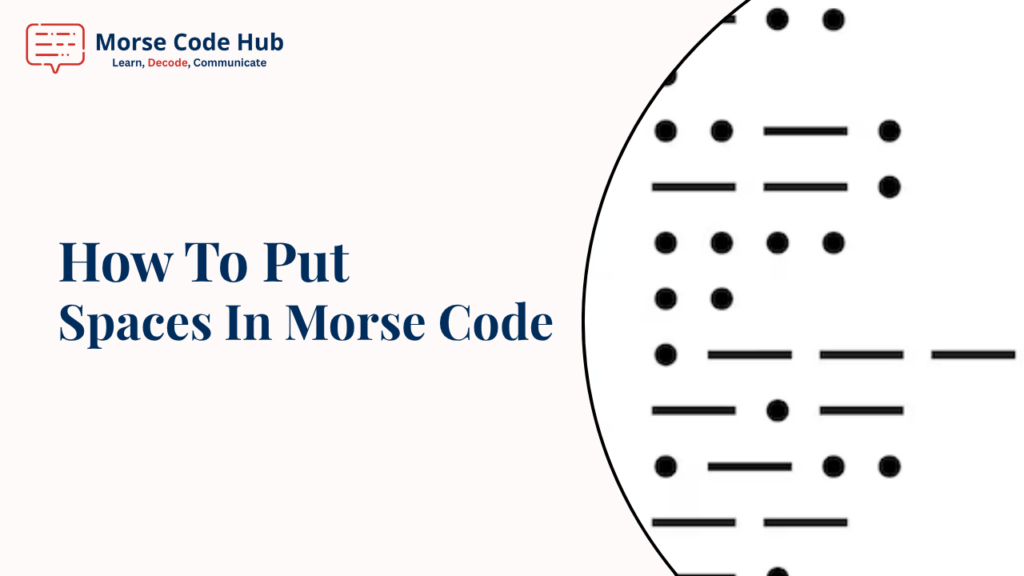Learning how to put spaces in Morse code is fundamental to sending and receiving clear, readable messages. This system of dots and dashes relies heavily on precise timing to distinguish letters and words, ensuring your message isn’t a jumbled mess. As a Morse code enthusiast who’s spent years tapping out messages and teaching others, I can tell you that spacing is where most beginners stumble, but it’s also where mastery shines. In this article, I’ll break down the rules of spacing, common pitfalls, and practical tips, drawing on historical standards and modern practices. With tools like those on Morse Code Hub, you can practice spacing across languages from Latin to Japanese, honing your skills.
Spacing Between Dots and Dashes (Same Letter)
In Morse code, each letter is a unique combination of dots (•) and dashes (–), also called “dits” and “dahs” when spoken. The space between dots and dashes within the same letter is critical and equals one dot duration. For example, the letter “A” (•–) has a dot followed by a one-dot-length pause, then a dash. As per CodeBug, it explains that a dot is one time unit, a dash is three time units, and the intra-letter space is one time unit.
This one-unit pause ensures the elements of a letter are distinct yet cohesive. At 20 words per minute (WPM), a dot lasts about 60 milliseconds, so the space between a dot and a dash is also 60 milliseconds, as noted by Ham Radio QRP. Without this pause, signals blur together, making “A” (•–) sound like “E” (•) followed by “T” (–). Practice this rhythm with our Morse code translator to perfect intra-letter spacing.
How to Separate Letters in Morse Code
To separate letters within a word, Morse code uses a three-dot duration pause, equivalent to one dash. For example, in the word “CAT” (–•–• / •– / –), a three-dot pause separates the “C” from the “A” and the “A” from the “T”. At 20 WPM, this pause is about 180 milliseconds, based on a 60-millisecond dot, as per Ham Radio QRP.
This spacing is critical because, without it, letters merge into ambiguous sequences. For instance, “HI” (•••• ••) could be misread as “SS” (••• •••) if the three-dot gap shrinks. Try encoding “CAT” with our words in Morse code tool to master this pause.
Word Separation: The 7-Unit Rule Explained
The seven-dot duration pause, or inter-word space, separates words in Morse code, ensuring clear message structure. For example, in “HELLO WORLD” (•••• • / •–•• •–•• ––– / •–– ––– •–• •–•• –••), a seven-dot pause divides “HELLO” from “WORLD”. At 20 WPM, with a 60-millisecond dot, this pause is about 420 milliseconds.
This rule, formalized in the International Morse Code standard by 1865, prevents words from running together. Without it, “I AM” (•• / •– –) could be misread as “SN” (••• –•). Practice word spacing with our numbers in Morse code tool to nail the seven-unit rhythm.
Common Mistakes with Spacing and How to Avoid Them
Spacing errors are the bane of Morse code beginners. One common mistake is rushing inter-letter spaces, shrinking the three-dot pause to one or two, causing letters to merge. For example, “AN” (•– –•) can sound like “W” (•––) if the gap is too short. To avoid this, count out three dots mentally or use a metronome set to your WPM.
Another error is inconsistent word spacing, either too short (under seven dots) or too long, disrupting the message’s flow. Using an electronic keyer, which enforces timing, helps, as 60% of ham radio operators rely on them for accuracy as per Ham Radio QRP. Finally, exaggerating dot or dash lengths throws off rhythm; keep dots at one unit and dashes at three. Regular practice with feedback tools can correct these habits.
Visual vs. Audio Morse: Spacing Differences
Morse code can be transmitted visually (e.g., flashing lights) or audibly (e.g., beeps), and spacing nuances differ slightly. In audio Morse, timing is everything, as listeners rely on pauses to parse letters and words. As referred to WikiHow, it emphasizes that audio learners should focus on rhythm, saying “dit” for dots and “dah” for dashes, with precise one-, three-, and seven-dot pauses. At 20 WPM, a three-dot letter space is 180 milliseconds, and a seven-dot word space is 420 milliseconds, as per Ham Radio QRP.
In visual Morse, like signal lamps or flashlights, spacing is harder to gauge because human perception of light pulses varies.. For example, a seven-dot word space might stretch to 460 milliseconds. During WWII, 70% of naval signal lamp communications used extended visual pauses to ensure accuracy, noted by Military.com. Practice both methods with our Morse code translator to compare their feel.
Practice Tips for Perfect Morse Code Timing
Mastering Morse code spacing requires deliberate practice. Here are proven tips to hone your timing:
- Use the Farnsworth Method: Learn letters at full speed (e.g., 20 WPM) but with exaggerated inter-letter and inter-word spaces (e.g., 5 WPM pacing). Apps like Morse-It simulate this.
- Practice with Audio Tools: Listen to Morse code audio files, writing down what you hear. Try our words in Morse code tool for practice.
- Tap Out Rhythms: Use a straight key or iambic paddle to send code, focusing on consistent spacing. Ham Radio QRP article suggests setting your transceiver’s break-in timing to 350 milliseconds at 20 WPM for word spaces.
- Record and Review: Record your transmissions and compare them to standard timing.
- Join a CW Community: Use our numbers in the Morse code tool to send clean code.
Conclusion
Knowing how to put spaces in Morse code—one dot between elements of a letter, three dots between letters, and seven dots between words—is essential for clear communication. Whether using audio or visual methods, tools like Morse Code Hub help you perfect spacing across languages. Tap into the rhythm of Morse code, and make your messages sing in 2025.



